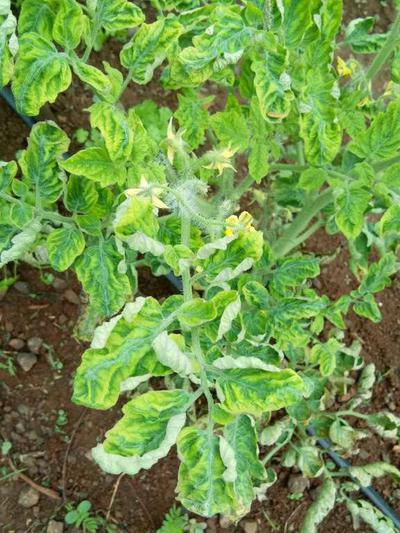Tomato Yellow Leaf Curl Virus
TYLCV
Virus
In a Nutshell
- Yellow and curled leaves.
- Stunted growth.
- Less number of fruits.
Can also be found in
Symptoms
Infection at seedling stage results in severe stunting of young leaves and shoots, leading to a somewhat bushy growth of the plant. In older plants, the infection results in excessive branching, thicker and wrinkled leaves, and interveinal chlorosis clearly visible on the leaf blade. At later stages of the disease, the plants take a leathery texture and their chlorotic margins are rolled upwards and inwards. If the infection takes place before the flowering stage, the number of fruits is considerably reduced, even though there are no noticeable symptoms on their surface.
Recommendations

Organic Control
There is no treatment against TYLCV. Control the whitefly population to avoid the infection with the virus.

Chemical Control
Once infected with the virus, there are no treatments against the infection. Control the whitefly population to avoid the infection with the virus. Insecticides of the family of the pyrethroids used as soil drenches or spray during the seedling stage can reduce the population of whiteflies. However, their extensive use might promote resistance development in whitefly populations.
What caused it?
TYLCV is not seed-borne and is not transmitted mechanically. It is spread by whiteflies of the Bemisia tabaci species. These whiteflies feed on the lower leaf surface of a number of plants and are attracted by young tender plants. The whole infection cycle can take place in about 24 hours and is favored by dry weather with high temperatures.
Preventive Measures
- Use resistant or tolerant varieties.
- Plant early to avoid peak populations of the whitefly.
- Intercrop with rows of non-susceptible plants such as squash and cucumber.
- Use nets to cover seedbeds and prevent whiteflies from reaching plants.
- Practice crop rotation with non-susceptible plants.
- Avoid planting alternative host plants close to crops.
- Mulch the seedbed or the field to break the life cycle of the whitefly.
- Use sticky yellow plastic traps to mass-catch the insect.
- Monitor the field, handpick diseased plants and bury them away from the field.
- Find and eradicate weeds in and around the field.
- Plow deep all plant debris after harvest or burn them.



